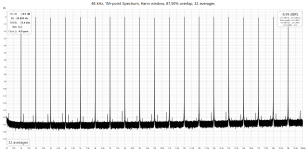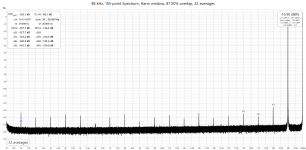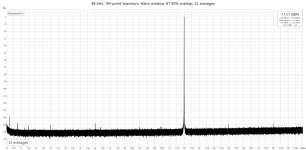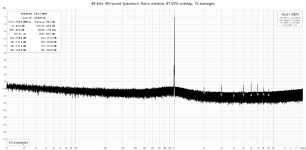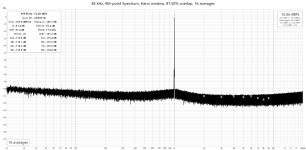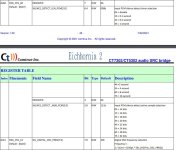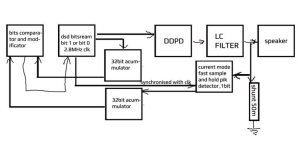Marcel,
I guess, your design is quite hard to simulate properly. It might take weeks if you are using a lot of gate-level IP from Xilinx.
My design is completely IP-free and can be simulated 100%, it takes few minutes to simulate 2**20 samples for math analysis. So, it was easy to verify absence of this blamed idle tones and DC offsets.
Anyway, even Matlab simulation of modulator only, without entire signal path, should provide fast and clear indication of the tones, hence it is a pure digital domain artefact.
I guess, your design is quite hard to simulate properly. It might take weeks if you are using a lot of gate-level IP from Xilinx.
My design is completely IP-free and can be simulated 100%, it takes few minutes to simulate 2**20 samples for math analysis. So, it was easy to verify absence of this blamed idle tones and DC offsets.
Anyway, even Matlab simulation of modulator only, without entire signal path, should provide fast and clear indication of the tones, hence it is a pure digital domain artefact.
Sorry Markw4,So, is everyone satisfied having seen one FFT?
I want to add some graphs you might interested in:
1. Multitone at -1dBFS
2. 12K 20Hz BW 4M FFT for clock purity assessment at 0dBFS.
3. CCIF at -3dBFS
4. 12K J-test with default settings.
I don't know how to measure sound stage. What is it?
Regards,
Attachments
Last edited:
Hurray! I have caught this famous idle tones!
It's nice to see, that PWM version is free from that issue.
Time was not wasted for nothing!
Carrier level is -60.01dBFS:
It's nice to see, that PWM version is free from that issue.
Time was not wasted for nothing!
Carrier level is -60.01dBFS:
Attachments
Last edited:
Is sound stage measureable? Serious question.
My understanding is that one needs good speakers (and ears) and experience to evaluate such things.
My understanding is that one needs good speakers (and ears) and experience to evaluate such things.
Hurray! I have caught this famous idle tones!
Carrier level is -60.01dBFS:
OK, so you don't have any offset and the idle tones are around -152 dBFS in your case, if I understand it correctly. That's some 20 dB softer than in my DAC using a version of olo111's and PJotr25's PCM2DSD. The difference can still be due to more effective dithering or a better DAC or both.
Is there any way you can play .dsf files without remodulating them? If so, could you please play the DSD128 .dsf file of post #2696, https://www.diyaudio.com/community/threads/return-to-zero-shift-register-firdac.379406/post-7652259 , and check the level of the spur close to 10 kHz?
Aha - sorry...Yes. It's a normal expression when you strongly disagree with someone, as far as I know.
So I was interested in your answer but I interpreted wrongly... so
- it's NOT a pure academic sport, or
- it's more than one formula that is important
or both? This just shows that I don't follow what is discussed ;-)
//
Might this help for pcm2dsd for cleaner dsd silence bits patern out? https://github.com/Ellerbach/PcmSilenceDectection/blob/master/README.md CT7302 seems have something similar too, I didn't tried out. A lot of things to figure out.
Attachments
Last edited:
This might be useful too in relation to dsd modulation http://archimago.blogspot.com/2021/10/measurements-look-at-dsd-and-using-sox.html?m=1
I'm afraid about multitone pcm2dsd implementation, anybody compared their conversion for example with conversion from sox to convert an 1k sinewave to dsd? Looks like sdm8 gives the best result?
I'm afraid about multitone pcm2dsd implementation, anybody compared their conversion for example with conversion from sox to convert an 1k sinewave to dsd? Looks like sdm8 gives the best result?
Last edited:
Its actually what good sound reproduction is supposed to be. Most people think its about distortion, but its not. Its something Siegfried Linkwitz was very interested in as can be seen from some of collected publications: https://www.linkwitzlab.com/publications.htm As it turns out, we find the dac is an essential part of reproduction chain which allows Linkwitz's so-called "magic" to occur.I don't know how to measure sound stage. What is it?
Aural sound localization is reviewed at: https://en.wikipedia.org/wiki/Sound_localization
Also, some references in my dropbox including a measurement technique: https://www.dropbox.com/scl/fo/58jh...DodsIaww?rlkey=jvxraclo3o20dpyraiy6hi672&dl=0
From the standpoint of a dac, the problem is to accurately reproduce lateral and depth localization cues (two different things). Phase coherence between channels needs to be within a few microseconds under all playback conditions, including with both channels playing different musical content. This requirement is for ITD lateral localization as described in the wiki article.
Depth cues mostly consist of direct to reverberant sound ratio, and loss of HF content with distance. This requirement means that very low level musical information such as may be on a well recorded CD, including room reverberations and their decays in the recording space (say, a concert hall) are plainly audible, at least if the volume level is turned up high enough.
For these spatial cues to be well audible also requires that the reproduction space where listening will take place is sufficiently acoustically treated; also the listener should be less than the critical distance from the speakers. Speakers need to be positioned to produce a good stereo image between them. Ideally the sound should not sound like its all coming out of the speakers; rather it should sound like sound also originates in the space between and behind the speakers, and also extending in width laterally beyond beyond the speakers themselves.
What I can tell you about Marcel's dac as it is configured here, is that it gives the most extensive and realistic soundstage experience we have heard here. Getting it to that point has required the use of exotic and costly clock oscillators (among other things). In order to evaluate soundstage here we use a very small number of selected recordings with which we are intimately familiar, and that are challenging to reproduce well.
Also, in my dropbox is a paper by Hawksford on objective measurement of a 3-D sound field.
Last edited:
From the standpoint of a dac, the problem is to accurately reproduce lateral and depth localization cues (two different things). Phase coherence between channels needs to be within a few microseconds under all playback conditions, including with both channels playing different musical content. This requirement is for ITD lateral localization as described in the wiki article.
That nicely explain why I like ddpd huge dynamic sound even it have very poor result on measurement. Dsd bits simply pass through the H bridge on dsd frequency tact without delay, similar to water flow heater, it simply has to have good dynamics, and dynamic is really audible, incomparable to anything I have had the opportunity to hear. But there is also a noise, I assume that there is some problem with the dsd bitstream as I hear noise for example when track have silence, it's really not clear to me. I will have to try to manually make a dsd128 track and line up the bits like this 10101010... just to see if there will be any noise on the speakers, I will do that one day when I have time to deal with it. Will do that when gan version get finished.
Last edited:
I have an idea in my head how to implement feedback for ddpd, but I have no idea how to make a fast current sample-and-hold simple precision 1 bit comparator, it just needs to be able to compare the previous sample with the new sample on the shunt resistor against the peak value on the resistor and produce a simple bit 1 or bit 0. That's some idea I don't know how to implement.
Attachments
Markw4,
AFAIK, sound stage is pure artefact created by sound engineer by mixing a lot of recorded tracks from a set of microphones.
Some of the channels are delayed, compressed, some muted or amplified. So, I never paid any attention to that.
For myself, the main criteria was feeling the sound is easy for listening, not making you very tiered in a hour.
AFAIK, sound stage is pure artefact created by sound engineer by mixing a lot of recorded tracks from a set of microphones.
Some of the channels are delayed, compressed, some muted or amplified. So, I never paid any attention to that.
For myself, the main criteria was feeling the sound is easy for listening, not making you very tiered in a hour.
Aha - sorry...
So I was interested in your answer but I interpreted wrongly... so
- it's NOT a pure academic sport, or
- it's more than one formula that is important
or both? This just shows that I don't follow what is discussed ;-)
//
Both, as far as I'm concerned.
You couldn't be more mistaken. At its essence, its one pair of condenser mics (usually large diaphragm types for low noise) placed in a concert hall to capture the sound of being there in person at a symphony performance. If you don't hear the room sounds and the instruments, soloist, etc., in their spatial locations as you would if you were there sitting in the best seats in the house, then maybe your dac is crap. Could be other problems too, but it starts with the dac. If the mics picked up all that acoustical information and the ADCs encoded it to digital, and then the dac can't reproduce the CD accurately enough (not more than 16-bits worth of dac performance when it comes right down to it), then that's a limitation of the dac performance, not something to blame on anyone other than the dac designer....sound stage is pure artefact created by sound engineer by mixing a lot of recorded tracks from a set of microphones.
Last edited:
It's not good if after an hour something annoying starts happening, it's an indicator that something is missing in the system.Markw4,
AFAIK, sound stage is pure artefact created by sound engineer by mixing a lot of recorded tracks from a set of microphones.
Some of the channels are delayed, compressed, some muted or amplified. So, I never paid any attention to that.
For myself, the main criteria was feeling the sound is easy for listening, not making you very tiered in a hour.
Yes this is true, it all depends a lot on the person doing the mix, such material will certainly suit someone who has a similar ear to the person who made it, and for example someone else will not like it. Regarding ddpd, unfortunately I don't have a tape in pure dsd, all the tapes I have are probably made from pcm to dsd conversion, and it seems to me that this is the reason why there is noise on the parts where there is silence, this shouldn't be the case with pure dsd tapes? Where I can buy pure 1bit dsd tapes, but has it been verified?
For example https://positive-feedback.com/interviews/mastering-engineer-tom-caulfield/
Last edited:
Maybe, but almost all ADCs are not natively PCM nor DSD. Its usually very high sample rate multibit sigma delta modulation, maybe 5-bits or so. Then its converted to standard format PCM or to DSD as desired. The conversion can be done inside the ADC chip or maybe in an external FPGA....all the tapes I have are probably made from pcm to dsd conversion
Also, although most ADCs contain an internal dac, that particular dac doesn't have the same requirements as a dac for final reproduction back to analog. The internal dac only has be accurate during the narrow time window when the analog input signal is compared to the dac output. A reproduction system dac has to be accurate all the time, because its output isn't sampled during a time window, rather its integrated over time so errors at any time can affect the output.
Today IO is still at the level of half ns or a little less and half of that less, as long as it's like that PCM will be popular. : ) The boundaries are moving slowly, I hope that in ten years it will be much different. Just look at the Topping B100 for example, how simple it is and how good it is : )
If PCM is not popular, its probably at least in part due to the "element matching problem." DEM, DES, Scrambling, and the like can make distortion look more like noise on an FFT. Doesn't mean it sounds like benign resistor noise (just a little hissss type of sound). What it sounds like really depends on the nature of the process that produces the noise in the first place. As I would hope we all understand by now, white noise can have a wide range of sounds and still look white on an FFT. Same basic thing for colored noise, such as pink or brown; it can still sound like various things, depending.
Just one example, temperature measurement on the basis of two similar frequencies, how much more precise it is, at least for three decades, than when it is done on the basis of vref, dac, adc...etc, but I want to say that it is similar in studio mastering, it is all based on the same principle dac, adc...etc, for dekades! I hope that the boundaries will move in the audio world too in ten years my hope. Take a look to this document! This graph also explains much -> https://www.diyaudio.com/community/attachments/freq-temp-png.1382059/ this measurement is done on the stm32 while measuring their crystal oscilator frequency while stm32 is inside an oven and on the right side is temperature measured by dac on the same stm32, how smooth is left side than right side of the picture graph! : )
Attachments
Last edited:
^That's for DDS type applications. If you need long term frequency stability to maintain channel separation in frequency-synthesized, frequency-multiplexed communication systems, then that's one thing.
Then there are audio dacs for human hi-fi listening. Rather different application in terms of the end goal. Also different in terms of the need for long term frequency stability (not that it hurts for audio, but it doesn't necessarily help either; Iancanada clocks are pretty good S-cut crystal oscillators for digital audio use but they aren't temperature controlled and don't need to be).
Then there are audio dacs for human hi-fi listening. Rather different application in terms of the end goal. Also different in terms of the need for long term frequency stability (not that it hurts for audio, but it doesn't necessarily help either; Iancanada clocks are pretty good S-cut crystal oscillators for digital audio use but they aren't temperature controlled and don't need to be).
Last edited:
- Home
- Source & Line
- Digital Line Level
- Return-to-zero shift register FIRDAC
